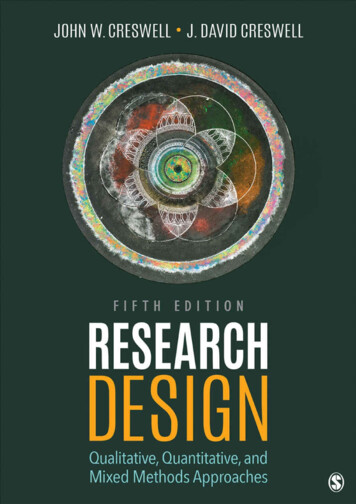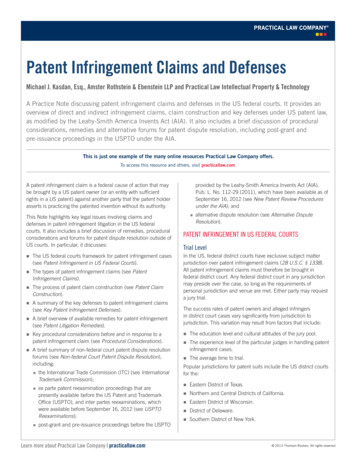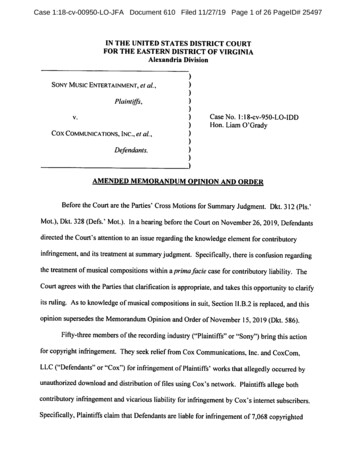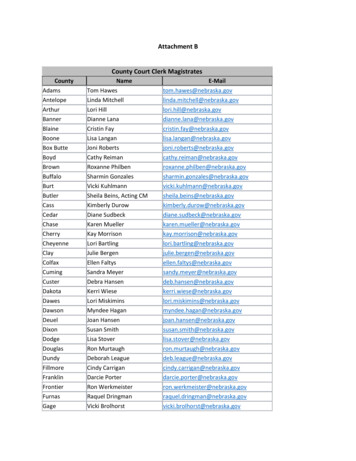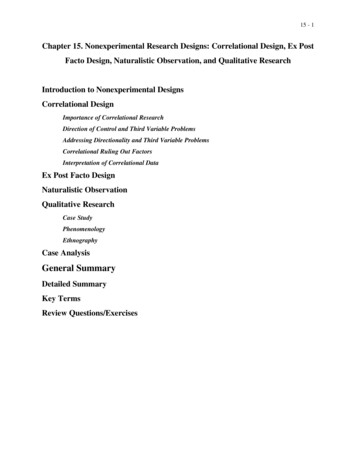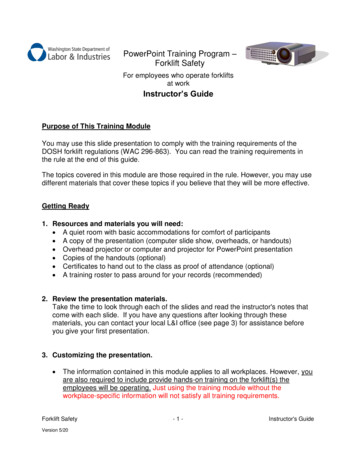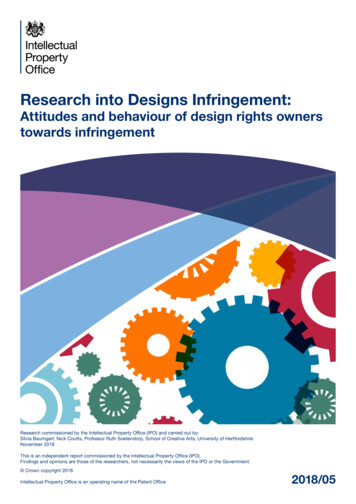
Transcription
Research into Designs Infringement:Attitudes and behaviour of design rights ownerstowards infringementResearch commissioned by the Intellectual Property Office (IPO) and carried out by:Silvia Baumgart, Nick Coutts, Professor Ruth Soetendorp, School of Creative Arts, University of HertfordshireNovember 2018This is an independent report commissioned by the Intellectual Property Office (IPO).Findings and opinions are those of the researchers, not necessarily the views of the IPO or the Government. Crown copyright 2018Intellectual Property Office is an operating name of the Patent Office2018/05
AuthorsProfessor Ruth Soetendorp is Professor Emerita andAssociate Director of the Centre for Intellectual PropertyPolicy and Management at Bournemouth University (UK).Visiting Academic at Cass Business School, City University ofLondon, teaching IP management on Masters in Innovation,Creativity and Leadership and BSc Business & Managementprogrammes.She is immediate past chair of the Intellectual PropertyAwareness Network and founding convenor of its EducationGroup. She led IPAN’s research with UK National Union ofStudents into students’ attitudes to IP, and University IPpolicies, and was IP lead on EUIPO’s recent research into IPeducation in schools. She is a regular contributor to the WIPOAcademy international programme. Nottingham Law Journalrecently published her reflection on 30 years as anIP educator.Nicholas Coutts is a Visiting Lecturer at UniversitatPolitèchnica de Catalunya (Masters in Business Innovation)(Spain) and works with ETICoop in France which has created68 startups to date and with Claned, Plumis, Repindex,Smartology and Waratek.Nicholas’s main interest is in the management of innovation;previously he was visiting lecturer at Imperial College(Management and Business for Computing Engineering;Design-led New Venture Creation); Imperial College BusinessSchool (executive education; IE&D MBA: Innovation,Entrepreneurship and Design) and the Royal College of Art(service design; IDE: innovation design engineering; GID:global innovation design) the Ecole Supérieure of AdvancedIndustrial Technologies (masters in systemics), AaltoUniversity (executive education: customer experience androutes to market) and the University of Tampere (executiveeducation: service design).Silvia Baumgart LLM is an associate solicitor at JamesWare Stephenson (London UK),Email: silvia.baumgart@jwssllp.comJames Ware Stephenson is a small boutique law firmspecialising in intellectual property matters.Prior to qualifying as a solicitor, she led the development of IPinformation resources and training for creative students andsmall businesses at the University of the Arts London, whereshe is a visiting lecturer. She was commissioned by the WorldIntellectual Property Organization and the Academy of theEuropean Patent Office to produce IP resources andlead workshops.This commissioned project was led by Dr Matthias Hillner(2015 to 2016) and by Professor Ruth Soetendorp incollaboration with Nick Coutts, managed by Dr StevenAdams, Associate Dean for Research for the School ofCreative Arts at the University of Hertfordshire, andcoordinated by Silvia Baumgart.ISBN: 978-1-910790-36-6Research into Designs Infringement:Attitudes and behaviour of design rights ownerstowards infringement.Published by The Intellectual Property OfficeNovember 20181 2 3 4 5 6 7 8 9 10 Crown Copyright 2018You may re-use this information (excluding logos)free of charge in any format or medium, under theterms of the Open Government Licence. To viewthis licence, visit http://www.nationalarchives.gov. uk/doc/open-government-licence/or email: psi@nationalarchives.gsi.gov.ukWhere we have identified any third party copyrightinformation you will need to obtain permission fromthe copyright holders concerned.Any enquiries regarding this publication should besent to:The Intellectual Property OfficeConcept HouseCardiff RoadNewportNP10 8QQTel: 0300 300 2000 Fax: 01633 817 777e-mail: information@ipo.gov.ukThis publication is available from our website atwww.gov.uk/ipo
ContentsIntroductionAcknowledgements and thanks12Executive summary3About the research5Aim and objectives5Methodology6Comparison with methodology developed by Weatherall and Webster12Terminology13Recommendations for further development of the methodology.15Clarifying terminology171. Respondents182. Designers’ attitudes and responses to infringement223. How the type of design right affects infringement314. Potential infringers’ attitudes365. Incidence of international infringement396. Distinguish between potentially criminal offencesand civil infringement407. Designers and the courts418. Media analysis469. Conclusion and recommendations48
4Research into Designs Infringement: Attitudes and behaviour of design rights owners towards infringementAppendices50Appendix 1: Questionnaire50Appendix 2: Survey data58Appendix 2: Questionnaires81Appendix 3: Respondents86Appendix 4: Research objectives and their corresponding hypotheses93Appendix 5: UK design right court decisions from 2013-1799Appendix 6: Media Survey108Data available on request1 1Data from Surveys 1 and 2Repindex Data (comments and interview data)Interview TranscriptsData will only be released in compliance with current UK and EU data protection laws. All data released willbe anonymised so that no respondent may be identified.
Research into Designs Infringement: Attitudes and behaviour of design rights owners towards infringementIntroductionInnovation is at the heart of the growth potential of a knowledge-based economy such asthat of the UK. The Design Council argues that the UK’s economic growth in the future willbe generated by design, or design processes that drive innovation and give the country acompetitive edge over others.In 2015,1 the Design Council reported that the design economy had contributed 7.2% ofgross value added (GVA) to the UK economy overall in 2013 – the equivalent of theconstruction and logistics sector. In its latest report, the Design Council suggested that theUK design economy had contributed 6% of the UK’s total gross value added (GVA) in 2015.2Overall, the design economy has grown much faster than the UK average: between 2009and 2013, GVA of the design economy increased by 27.9%3 while it increased by 42%between 2011 and 2015.4There is some evidence that the design sector as a whole is thriving, and that the use ofdesign improves the productivity of firms in other sectors – e.g. financial, high valuemanufacturing, IT and communications or utilities – that engage actively with design.5 Suchfirms realise that design can give them a competitive edge by integrating design processesinto their research and development (R&D) and as a result developing innovative productsand services which are more attractive to consumers.The role played by design in innovation is difficult to describe. Traditionally, indicators usedto measure innovation were patents and expenditure on R&D.6 Only since the beginning ofthe 21st century has research focussed on the impact of design on business performance,and it is even more recently that registered design rights have been explored for theirsuitability as indicators of innovation.7National registers of design rights, and the EU IPO’s register of EU design rights, provide anobjective and comparable data set at least within the EU member states whose designrights are widely harmonised. However, simply comparing the number of designregistrations by country or business sector is not a suitable method to determine thepotential of innovation in that country or sector. The lack of substantive examination meansthat various factors are not considered. For example, it is likely that not all registereddesigns meet the legal requirements for a valid registered design,8 the motivations forregistrations vary from sector to sector or even from company to company within a sector,and there are many reasons not to register a design but to rely on unregistered rights.9Considering that the purpose of protecting designs through policy and legislation is toencourage innovation and reward the design owner for their contribution to the GVA, thereis still little knowledge based on reliable evidence about the effectiveness of the legalsystem to achieve its aim.123456789Design Council. (2015) The Design Economy: The value of design to the UK. London: Design Council, p 18.Design Council. (2018) Designing a Future Economy: Developing design skills for productivity andinnovation. London: Design Council, p 40.Design Council. (2015) The Design Economy: The value of design to the UK. London: Design Council, p 18.Design Council. (2018) Designing a Future Economy: Developing design skills for productivity andinnovation. London: Design Council, p 40.Design Council. (2015) The Design Economy: The value of design to the UK. London: Design Council, pp27-28.Wolf, P. (2017) MSc thesis: Registered design rights as an innovation indicator. Unpublished manuscriptsubmitted to the School of Management at Technical University of Munich, p 10.Ibid. p 11.Between 2013 and 2017, IPO tribunal heard 36 applications to declare a registered UK design right invalid.21 were successful (58.3%). Two of them were invalid due to issues related to proprietorship, the rest dueto not meeting requirements of novelty and individual character. (See Appendix 5.1).Filitz, R. et al. (2015) Protecting Aesthetic Innovations? An exploration of the use of registered communitydesigns in: research policy 44, pp 1,192–1,206.1
2Research into Designs Infringement: Attitudes and behaviour of design rights owners towards infringementThis research project contributes to the debate from a different perspective. It seeks tounderstand the attitudes and behaviour of designers and design right owners when theyexperience infringement of their design.This approach provides an insight into motivations of design right owners to protect theirdesigns, how and why registered and unregistered design rights are enforced, and the levelof infringement experienced by design rights owners. It measures loss caused byinfringement and consequently, the value of design rights to the design right owner.It will enable policy makers to draw conclusions about how well the current system fulfils itsultimate purpose, whether changes are necessary and what kind of support is needed fordesign rights owners to effectively protect and enforce their rights.The aim is to set out a repeatable methodology to track change of attitudes over time andshape UK policy on design protection and enforcement based on reliable evidence.Acknowledgements and thanksThe research team comprising Matthias Hillner (Principal Investigator from 2015 to 2016),Silvia Baumgart (Trainee Solicitor, James Ware Stephenson), Nicholas Coutts (Visiting Tutor,Royal College of Arts, London) and Ruth Soetendorp (Professor Emerita, BournemouthUniversity), in conjunction with University of Hertfordshire, acknowledges the interest andsupport shown to the project by the design community and the IPO Research AdvisoryCommittee.We would like to thank Dave Green at the University of Hertfordshire, who helped us tonavigate the challenging logistics of the research project, and Dr Steven Adams, AssociateDean for Research for the School of Creative Arts at the University of Hertfordshire, whomanaged the project.Professor Joanna Gibson’s critical comments helped shape our thinking and methodologyin analyzing our data and drawing conclusions. Sarah Gavin assisted us in setting up andimplementing the social media campaign, and Octavia Coutts researched the reporting ofkey design rights cases in the media. Their work added important insights and context tothis report.We would like to thank everybody who completed the questionnaire, took part in our focusgroup or assisted with our social media campaign for their time and support. Lastly, ourthanks go to David Humphries, Head of Research at UK Intellectual Property Office, for hissupport and guidance.
Research into Designs Infringement: Attitudes and behaviour of design rights owners towards infringementExecutive summaryThe design economy is growing. According to the Design Council, more than half a millionpeople are employed in UK design industries, while another million designers work in othersectors. In 2015, the UK design economy was worth 6% of the nation’s total economy – thesame as the building industry and the logistics sector combined. And yet, very fewdesigners and design right owners are proactive about protecting their intellectual property.The UK Intellectual Property Office (UK IPO) commissioned this research to address thelack of existing data on design infringement. This report measures the incidence of designrights infringement in the UK and looks at attitudes to design rights – and infringement –among designers and design right owners. In so doing it provides a snapshot of the UK’sdesign industry, including a look at which rights designers value, the impact of infringementand what happens when designers go to court.While measuring the extent and scale of design rights infringement in the UK, we aimed toproduce a robust methodology that would improve future research in this area. So we havereported extensively on our methodology, and the thinking behind it, here.Key findingsMost designers work either on their own or for small companies and studios. Nearly threequarters of respondents to our Surveys were sole traders, or working for – including owning– a small company with fewer than ten employees.Infringement is common, with most (98.3%) designer rights owners having experience of it.Innovative designs with a disruptive quality tended to be infringed more frequently than lessinnovative designs.Perhaps it is unsurprising therefore that almost all design rights owners monitor forinfringement, many by searching design rights registers, employing legal help or monitoringtrade journals. Other methods mentioned included searching online and attending tradefairs to check out competitors. However, most rely on customers and suppliers to raise thealarm when their design rights are infringed.When they do discover that their intellectual property rights have been infringed, the mostcommon action is to send a letter to the other party. About one-third contact a lawyer, butmany of our respondents (43%) reported that pursuing legal action was ‘too costly’. Fromour telephone interviews, we learnt that some designers and design rights owners refrainedfrom taking action because they didn’t think the potential gain would justify the cost. This isdespite the fact that a sizeable number of them had lost considerable sums in revenue dueto infringement, and half had expended valuable staff time on defending their IP.When designers do go to court, their primary motivation is defending their intellectualproperty as a matter of principle. We found that commercial considerations were not themain motivation to enforce rights, for either claimants or defendants.However, it appears that disputes are not as common as the incidence of infringement itself.While most designers and design rights owners had experienced infringement – andexperienced revenue losses as a consequence – fewer than 10% of our respondents hadbeen involved in a dispute.When it came to protection, respondents to our Surveys cited patents as being the mosteffective, followed by trade marks, registered design right, copyright, and unregistereddesign right. We had presupposed that litigation involving registered design rights was morecommon than that for unregistered design rights, but this proved not to be the case. Thisalso confirms the analysis of court cases between 2013 and 2017 where unregistereddesign rights are more frequently at issue than registered design rights.3
4Research into Designs Infringement: Attitudes and behaviour of design rights owners towards infringementHowever, owners of registered design rights were more likely to seek legal advice ondiscovering their rights had been infringed, than owners of unregistered design rights.According to Survey respondents, registered designs seem to be easier to defendsuccessfully than unregistered ones but in reality, court cases may involve bothunregistered and registered design rights. An analysis of court cases involving design rightsfrom 2013 to 2017 shows that only 50% of registered design rights are successfullydefended, while the success rate for defending unregistered design rights is nearly 70%.Most infringers will cease and desist when challenged by the design right owner, usuallypermanently. However, larger companies were more likely to ignore an infringement claim orallege that a design wasn’t valid. As we had suspected, infringement occurs predominantlyin relation to products that have proof of market, but we couldn’t verify our hypothesis thatthe retail sector is flagrantly infringing design rights. If current law extended to unregistereddesign rights, 16% of all design right infringements experienced by respondents to ourSurveys would be regarded as criminal offences.In international disputes, China was the most frequently cited country among ourrespondents, followed by the USA. Some respondents had had design rights infringed inmore than one foreign country, but only a small number reported international infringementof their design rights.RecommendationsTo build on the methodologies developed in this research, and by Weatherall and Websterfor their 2010 study which measured patent infringement in Australia, in future studies of thiskind, we recommend that: data should be collected regularly by the UK IPO through their communicationchannels and educational projects.any future research should aim to increase participation amongst potential owners ofunregistered design rights.more consideration should be given to the wording in future questionnaires: it shouldbe more precise to provoke more informative responses, or more granular detail.negative questioning (e.g. asking what respondents have not heard of) shouldbe avoided.To enable the design sector to better protect design rights, we recommend that theIntellectual Property build on its work in the following areas: education: using communications channels, and working with trade associations, toteach and inform designers and design rights owners about their design rights.accessible guidance: providing guidance in plain English to the court process that isspecifically tailored to the design sector.pro bono legal advice: encouraging the legal profession to offer more pro bono adviceto designers and design rights owners, and to always be clearer about long-term coststhat may be incurred when defending design rights.
Research into Designs Infringement: Attitudes and behaviour of design rights owners towards infringementAbout the researchAim and objectivesThe UK Intellectual Property Office (UK IPO) commissioned this research to address thelack of existing data on design infringement.10 In this research project, we set out to: produce a robust research methodology suitable for replication.and measure the extent and scale of design rights infringement in the UK.The report focuses on the incidence of infringement experienced by design rights ownersand, where possible, provides a monetary value of that infringement. We also wanted toassess how frequently Surveys of this kind should be repeated so that trends ofinfringement can be recorded over time.To this end, the wider objectives within the proposed methodology were to:1.Understand designers’ attitudes and response to infringement.Our questions aimed to discover how design rights owners monitor the market forinfringement, and their reactions to infringements – ranging from sending a letter tothe alleged infringer, to court action. We wanted to discover more about their levelsof confidence in registered and unregistered rights. Our enquiry extended tounderstanding how levels of knowledge of design rights influence the chosenmethod of protection, and how methods of enforcement correlate with the type ofdesign, characteristics of the business or experience of designer. We also wantedto know how infringement is influenced by the size of a design business, the typeof product, or the commercialisation stage of product.2.Understand how the type of design right (registered or unregistered) affectsthe incidence and level of infringement.Throughout the research, our questions and data analysis differentiated betweenregistered and unregistered design rights where possible and appropriate.3.Understand the attitudes and behaviour of potential infringers towardsdesign right infringement.Respondents had to state whether they were answering questions as claimants ordefendants (alleged infringers). Their status was taken into account in the analysisof the data and differences highlighted.4.Produce an estimate for the incidence of design infringement against UKdesigners internationally.Questions about countries involved in design right infringements – and the level ofincidents experienced by respondents involving international design – produced anestimate for the incidence of design infringement against UK designersinternationally. However, we didn’t have enough external data to underpinthe findings.5.Distinguish between potentially criminal offences and civil infringement.We combined two questions – one about the quality of the infringing copy, and oneabout the motivation of the infringer as perceived by the respondents – to mirrorthe conditions in current legislation, which may lead to criminal sanctions for theinfringement of registered design rights. Unlike current legislation, our questionsdid not distinguish between registered and unregistered design rights butproduced a result for both taken together.10 Moultrie, J. (2011) Design Economics, Chapter 3: Design right case studies. London: UK IntellectualProperty Office, and Collopy, D. (2014) Measuring infringement of intellectual property rights. London:Intellectual Property Office, pp 81-825
6Research into Designs Infringement: Attitudes and behaviour of design rights owners towards infringementMethodologyTo get the fullest possible picture, the Design Rights Infringement Survey 2016 adopted amixed method enquiry. This combined a questionnaire-based Survey with a series oftelephone interviews.We arrived at this methodology after considering Dennis Collopy’s 2014 study, Measuringinfringement of intellectual property rights.11 This study looks at the different methodologiesused and highlights ‘the paucity of relevant research literature’12 on design rights. Indeed,few studies to date have concentrated on this form of intellectual property (IP). The authorsargue that measuring the infringement of design rights is difficult due to the number offactors – for example, registered and unregistered design rights, the small number of courtcases, and the incidents of infringement happening outside of the UK — and because of thelikelihood of design rights overlapping with the infringement of other rights such ascopyright, trade marks, passing off, breach of confidence etc.Collopy et al13 noted that ‘the nature of most infringements [bears] striking parallels withpatents (which in the US are described as ‘design patents’)’ and ‘all such infringement [is]based on business-to-business activity and rarely, if ever, [involves] the consumer’. For thisreason, they recommended a methodology developed by Weatherall and Webster for theirstudy of patent infringements in Australia.14One key difference between a Survey into design rights infringement and a Survey intopatent infringements, is that the owners of design rights are likely to be a larger, morediverse group, who are more difficult to reach than the proprietors of patents. Patents bytheir nature are registered rights. Their owners have made strategic business decisions toregister patents. Design rights however, comprise registered and unregistered rights – withowners of unregistered rights sometimes unaware that they own such rights, or, as theDesign Council UK found in 2010, 66% of designers Surveyed taking no action to protecttheir IP.15While contact details of owners of patents are available through the registry, the contactdetails of owners of unregistered rights are not readily available. This makes it necessary tomake assumptions about their identity and then develop a strategy to reach them, forexample through social media or trade bodies.11 Collopy, D. (2014) Measuring infringement of intellectual property rights. London: IntellectualProperty Office.12 Collopy, D. (2014) Measuring infringement of intellectual property rights. London: Intellectual PropertyOffice, p 20.13 Ibid.14 Weatherall, K.G. and Webster, E. (2010) Patent Infringement in Australia: Results from a Survey. Melbourne:Intellectual Property Research Institute of Australia, University of Melbourne.15 Design Council (2010) Design Industry Research Report: Factsheets, London: Design Council, p 1.
Research into Designs Infringement: Attitudes and behaviour of design rights owners towards infringementSurvey stagesTo ensure statistical validity, we needed to reach a sufficient number of owners of registeredand unregistered design rights. For this reason, the design rights infringement Survey wasrolled out in four stages:1.Quantitative Survey 1: A postal questionnaire (see Appendix 1) targeted registereddesign companies who hold a registered design (RD) or a registered communitydesign (RCD). We obtained contact details via registers held by the EuropeanUnion Intellectual Property Office (EU IPO), formerly the Office for Harmonization inthe Internal Market (OHIM), and the UK Intellectual Property Office (UK IPO).2.Quantitative Survey 2: We extended the investigation to holders of UK unregistereddesign rights (UKUDR) and unregistered community design rights (UCDR). Thequestionnaire targeted potential design right owners whose contact details wereobtained through Fame16 – a database of companies registered in the UKand Ireland.3.Quantitative Survey 3: An online questionnaire targeted individual designers andmicro businesses that are not incorporated entities and, therefore, not included inthe Fame database. We promoted the opportunity to take part in the Surveythrough the media communication channels of design industry associations. ThisSurvey was run in parallel to quantitative Survey 2.4.Qualitative Survey: we had usable telephone interviews from 24 respondents whichcontributed to the research. We used the objectives as prescribed by theIntellectual Property Office to map the questions, with the aim of gathering datathat were unlikely to emerge through the quantitative Surveys alone.To help us develop the questionnaire, we held a focus group meeting. After feedback fromparticipants, we included open questions (see Appendix 2.4) in the telephone follow-upSurvey. This allowed respondents to address issues not covered by the questionnaires andto contextualise findings.We also ran a pilot questionnaire before quantitative Survey 1, by posting it to a smallnumber (300) of registered design right owners.16 Fame is a database of companies in the UK and Ireland covering, among others, financial information, SICcodes and contacts of directors and key managers, published on the Bureau van Dijk website: -information/national-products/fame7
8Research into Designs Infringement: Attitudes and behaviour of design rights owners towards infringementQuestionnaire designFocus groupPrior to targeting relevant design right owners and finalising the questionnaire, we organiseda focus group comprising: a designer who owns a small to medium-sized design business.two legal representatives of design companies, one large and one small.and two representatives of different design stakeholder groups.We established the focus group to discuss: important topics of research, as outlined in the tender document.appropriate questions and approaches to the Survey, that would meet the objectives ofthe research project and interests of the various stakeholders.We documented key points made during the discussion by taking notes and audiorecordings, which were reported to the IPO.17 The focus group raised the following issues,which we were then able to address in the questionnaire and telephone interviews.Target audience and stakeholder groupsThe focus group advised us to target designers of consumer goods, such as fashion,furniture, homewares, packaging, medical equipment etc and to include retailers andmanufacturers of such products.This still left us with a very wide range of business sectors. We therefore decided to selectcontacts from the EUIPO’s and UKIPO’s list of registered design rights holders randomly.Since design right applicants are not required to indicate their area of business in theapplications (only an indication of the type of product to which the design is applied) it wasnot possible to identify the business sectors they represent without additional research.This would have exceeded our financial resources.We used the Fame database18 for the first and second email campaign, targetingunregistered design rights holders because it allowed us to select contacts by ‘standardindustrial classification’ (SIC) codes.19 (See Appendix 3.2.)We used an analysis of a 2015 report by Trends Business Research Ltd – as well as adetailed analysis of companies involved in design rights disputes20 – to choose a range ofSIC codes for the first Fame database mailing.The first selection method of SIC codes was based on reasonable assumptions rather thanfact-based evidence, because it is difficult to target firms that do not know they havecreated unregistered design rights. For the second Fame email campaign, we decided towiden the range of SIC codes to include possible design rights holders in a range ofindustries. We onl
School (executive education; IE&D MBA: Innovation, Entrepreneurship and Design) and the Royal College of Art (service design; IDE: innovation design engineering; GID: global innovation design) the Ecole Supérieure of Advanced Industrial Technologies (masters in systemics), Aalto University (executive education: customer experience and
